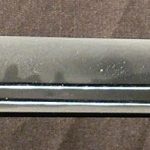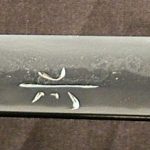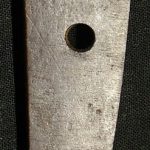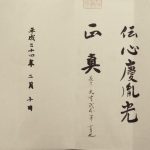TANEMITSU TANTO / WITH KOSHIRAE & SHIRASAYA
TANEMITSU
TANTO
NTHK KANTEISHO – DEN SHINKEI TANEMITSU
c. 1861
SUGATA: HIRA ZUKURI
FUJISHIRO RATING: CHUJOSAKU
MEI: MUMEI
DATE: NONE
NAGASA: 27.9cm (11″)
OVERALL: 37.78cm (14.875″)
MIHABA: 3.175cm (1.25″)
KASANE: 0.63cm (0.25″)
SORI: 2.22cm (0)
NAKAGO: UBU
MEKUGI ANA: ONE
YASURIME: KIRI
MUNE: IORI
HADA: MOKUME
HAMON: HITATSURA
BOSHI: MIDARE KOMI
HORIMONO OMOTE: SUKEN
HORIMONO URA: BONJI
HABAKI: ONE PIECE GOLD FOIL
SHIRASAYA / KOSHIRAE
TANEMITSU
Tanto attributed to Den Shinkei Tanemitsu. Tanemitsu was a student of Noatane and his works are said to resemble his teacher’s.
Fujishiro’s rates Tanemisu’s works as Chujosaku. His works can be seen in the Nihonto Koza pg. 108, Fujishiros pg. 146, and the Shinshinto Taikan pg. 231.
From Sesko’s, Swordsmiths of Japan (2015):
TANEMITSU (胤光), Bunkyū (文久, 1861-1864), Hitachi – “Shinkei Tanemitsu” (心慶胤光), “Shinkei Tanemitsu tsukuru” (心慶胤光造), “Tsuchiura-shin Nagao Shinkei Fujiwara Tanemitsu” (土浦臣長尾心慶藤原胤光), real name Nagao Eikichi (長尾栄吉), he was born on the 14th day of the fourth month Tenpō three (天保, 1832) as oldest son of Sudo Kume ́emon (須藤粂右衛門) in the village of Nakatate (中館) in Hitachi ́s Makabe district (真壁郡), he studied under Taikei Naotane (大慶直胤) and used the gō Shinkei (心慶), on the seventh day of the seventh month Ansei one (安政, 1854) he succeeded as head of Monju Kanesada’s (文珠包定) Nagao family (長尾), Kanesada worked for the Tsuchiura fief (土浦藩) but his lineage had ended during the Genroku era (元禄, 1688-1704) with its 2nd gen., Tanemitsu tried to revive this lineage, from the fifth year of Ansei (1858) onwards he worked in front of the gates of Tsuchiura Castle (土浦城) but with the Meiji era he moved to the town of Manabe (真鍋), there he died on the eleventh day of the twelfth month Meiji 34 (明治, 1901) at the age of 70, his posthumous Buddhist name is Seisō Dōei (清叟道栄), he worked mostly in the Bizen style of his master Naotane but also some excellent Sōshū blades are extant, he also signed in the archaic reisho script (隷書), some blades bear horimono, chūjō-saku
The workmanship seen in this blade is quite nice and atypical for Shinshinto. The Hada exhibited is Itame with areas of swirling Mokume and not the standard muji seen in so many works from this period. The Hamon is listed on the worksheet as Hitatsura. Nie and ji-nie literally cover the blade. There are chikei, and sunagashi. There are Bonji Horimono on the Ura side and a Suken Horimono on the Omote.
Sword comes with koshirae and shirasaya.
SOLD



